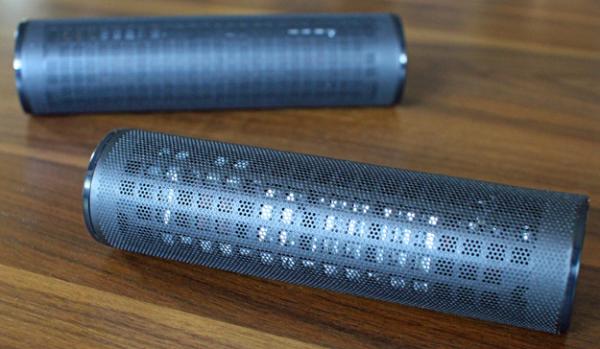Review: DVDO Air Wireless for HDMI Connection System

For most people, running a 1-meter HDMI cable to their TV is the only connection they need to make to experience a glorious 1080p picture. But mount that TV on a wall, or decide to go with projection, and you have a problem: the wires. Sure you can run HDMI cables through your walls or ceiling (or down to your basement), but sometimes that's just not easy - or possible.
As Daniel Kumin found in his recent "Something in the Air" article, sending HD signals wirelessly is not only possible, it's now practical, and even affordable.
New on the scene is DVDO's Air, one of the more interesting-looking products in this category. Curious how well it stacks up? How convenient. Me too.
They receiver and transmitter units look like cylindrical speakers, or plastic bazookas. In a way, they blend in well enough with other AV gear. The transmitter is slightly larger than the receiver; each on either side of the diameter of a paper towel tube. The Air is a one-in, one-out device, which is fairly common, though some in this price range feature two or more ins and sometimes more than one out. As I would hope S+V readers use a receiver for audio, the lack of HDMI switching isn't a huge deal in my book (at least, in this case).
What is somewhat disappointing is the power supply - a pair of proprietary wall warts. The transmitter and receiver must be powered from an A/C outlet. With many new products shipping with USB connections (like TVs and receivers), running off the power supplied by USB would provide an even simpler and more elegant install. To be fair, most of the Air's competition don't run off USB either, but some do, so I'd consider that an added bonus to look out for while you're shopping around.
The Wireless HD (also called WiHD) standard runs all the way up in the 60 GHz realm. There's no chance it will interfere with or get flustered by all the 2.4 GHz products you have in your home (namely, Wi-Fi and cordless phones). It supports everything up to 1080p, including 3D and of course audio. It is an in-room solution only, though, and has limited success transmitting through walls. More on that later.
Install is simple. Just plug the transmitter and receiver into an outlet, then run the HDMI cables (source to Air transmitter, Air receiver to TV). Power everything up, and it should auto-sync and be ready to go. You can wall-mount the receiver, or use the (included) plastic shelf to mount it to the top of a wall-mounted flat panel. That's a lot of wires (one more HDMI cable than a "wired" setup, technically, though they're shorter) for a "wireless" system - but I digress.
My install consisted of my equipment rack, which is mid-room, and a projector, at the back of the room. For a more extreme test, I ran an extra long HDMI cable from a Blu-ray player to the transmitter, which I plugged into an extension cord. This allowed me to vary the distance of the transmitter to see how far I could get.
In room, at a distance of 10-15 feet, I experienced no issues syncing up, and the image produced was clear of any artifacts. A 1080p/60 (the current maximum HD resolution) 1-pixel on/off test pattern and numerous video clips showed full detail and no extraneous noise.
The 60 GHz technology's main weakness is how easy it is to flummox. The tiny waves are easily blocked. With some devices using this technology, you can disrupt the signal just by walking in front of the transmitter. The Air is more robust than that, as I was able to stand directly in front of the transmitter with no loss of sync. The bigger issue with such limited penetration capacity is the inability to place the transmitter inside some cabinets. Your mileage here will vary, of course, but when I placed the DVDO transmitter behind a thin wood divider, I didn't lose signal.
However, move the Air a little too far away, around a corner, or place it behind too thick of a wall, and all signal is lost. It's best to think of the Air's connection as a little better than infrared (like a remote control). It might work in a cabinet with a door closed, or just outside of exact line of sight - but probably not. If the transmitter and receiver can see each other, they're a lot happier.
As with all such systems, there is a slight delay of the video, so if you're using an A/V receiver (as already presumed), and slight lip sync issues bother you, your best to find an A/V receiver that can delay the audio (also called lip sync adjustment).
Bottom Line
So there's nothing wrong with the Air, except, well, one thing. It's certainly cheaper than Gefen's luxury offering, but other similarly performing Wireless HD solutions can be had for around $200. The better performing, higher-featured, IOGear Wireless 3D HDMI Kit is $50 cheaper than the Air. If we go by street price, the IOGear unit is $130 cheaper. The IOGear works across your house, has two HDMI inputs, two outputs, and runs off USB. So it's hard to recommend the Air even though it works exactly as advertised, and looks kinda cool.
- Log in or register to post comments






























































